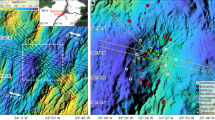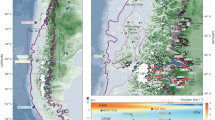Abstract
THE eastward volume transport of the Gulf Stream south of New England varies within a wide range. Within a triangle whose apex is at Bermuda and whose base extends from Cape Hatteras to Cape Sable, Nova Scotia, there have been 32 reliable oceanographic sections made across the Stream between 1932 and 1968. Geostrophic volume transports for these sections, computed relative to 2,000 m, are shown in Fig. 1. This 2,000 m surface is necessary if any seasonal change in transport is to be detected; only 10 of these sections reach to the ocean bottom (∼4,500 m), and these were all made between April and August. These results tend to confirm an earlier suggestion1 that the Gulf Stream is strongest in late winter and weakest in late autumn; this was attributed to the strengthening of the zonal winds in the winter. More recently, I have postulated a different mechanism for this annual variation in transport. The two most intense ocean currents, the Gulf Stream and the Kuroshio, are found on the western side of northern hemisphere oceans. These oceanic regions are visited throughout the winter by frequent outbreaks of frigid polar continental air. As a result of these outbreaks, very deep mixed layers are formed immediately south of these currents in late winter. The greatest thermocline depths are always found directly beneath the most deeply mixed layers, and it is primarily the variations in thermocline depth which account for the variations in computed transport shown in Fig. 1; the deeper the thermocline south of the Stream, the larger the transport. I suggest that the Gulf Stream receives a new charge of energy at the end of each winter due to this deepening of the thermocline. Here I discuss how the cold winter of 1976–77 influenced the Gulf Stream transport.
This is a preview of subscription content, access via your institution
Access options
Subscribe to this journal
Receive 51 print issues and online access
$199.00 per year
only $3.90 per issue
Buy this article
- Purchase on Springer Link
- Instant access to full article PDF
Prices may be subject to local taxes which are calculated during checkout
Similar content being viewed by others
References
Iselin, C.O'D. Pap. Phys. Oceanogr. Met., 8, No. 1, 1–40 (1940).
Worthington, L. V. In Studies in Physical Oceanography—a tribute to Georg Wüst on his 80th birthday (ed. Gordon, A. L.) 1, 169–178 (Gordon and Breach, New York, 1972).
Thomson, C. W. in The Atlantic, 1, 1–424 (Macmillan, London, 1877).
Fuglister, F. C. Prog. Oceanogr. 1, 265–373 (Pergamon, London, 1963).
Worthington, L. V. The Johns Hopkins Oceanographic Studies no. 6, 110 (The Johns Hopkins University Press, Baltimore, 1976).
Worthington, L. V. Deep-Sea Res. 5, 297–305 (1959).
Welander, P. in The Atmosphere and the Sea in Motion (ed. Bolin, B. B.) 95–101 (Rockefeller Institute Press and Oxford University Press, New York, 1959).
Masuzawa, J. in Kuroshio: Its Physical Aspects (eds. Stommel, H. & Yoshida, K. 95–127 (University of Tokyo Press, Tokyo, 1972).
McCartney, M. S. Deep-Sea Res. Suppl. 24 (in the press).
Author information
Authors and Affiliations
Rights and permissions
About this article
Cite this article
WORTHINGTON, L. Intensification of the Gulf Stream after the winter of 1976-77. Nature 270, 415–417 (1977). https://doi.org/10.1038/270415a0
Received:
Accepted:
Issue Date:
DOI: https://doi.org/10.1038/270415a0
Comments
By submitting a comment you agree to abide by our Terms and Community Guidelines. If you find something abusive or that does not comply with our terms or guidelines please flag it as inappropriate.



